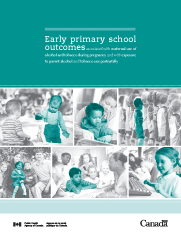ARCHIVED - Early primary school outcomes associated with maternal use of alcohol and tobacco during pregnancy and with exposure to parent alcohol and tobacco use postnatally
Early primary school outcomes
Executive Summary
Objective
The main purpose of the present study was to analyze longitudinal data from the Better Beginnings, Better Futures (BBBF) prospective study to examine relationships between prenatal exposure to alcohol and tobacco, separately and in combination, on developmental outcomes in young children from disadvantaged Ontario communities over the first four years of primary school (i.e. from 4 to 8 years of age). We also examined the effects of postnatal exposure to maternal drinking and smoking.
Four hypotheses were explored:
- Children with higher-risk drinking mothers would show poorer developmental outcomes than those with lower-risk drinking mothers.
- Children whose mothers smoked during pregnancy would show poorer developmental outcomes than those whose mothers did not smoke.
- Children whose mothers were both high-risk drinkers and smokers during pregnancy would show the greatest developmental problems during primary school.
- Maternal drinking and smoking during pregnancy would be more predictive of children's primary school problem behaviours than postnatal exposure to parental drinking and smoking behaviour during the preschool years.
Methodology
Two sets of statistical analyses were used. First, analysis of covariance (ANCOVA) allowed us to determine whether prenatal exposure to alcohol and/or tobacco may have differential effects on various aspects of children’s functioning during the early primary school years. This first analysis was designed as a “proof-of-concept” or exploratory model. Measures in five domains of child development outcomes were analyzed in the ANCOVA analysis: general development, cognitive development/academic performance, social/emotional functioning, behaviour problems, and physical health.
Second, based on results from the ANCOVA, a more complex statistical technique (structural equation modelling [SEM]) was used to examine the pathways from prenatal and postnatal exposure to alcohol and tobacco, to parent and teacher reports of children’s behaviour problems at age 8 (Grade 3). In this first-path analysis of this large and complex dataset, we focused on children’s externalizing (misbehaviour and problem behaviour) and internalizing (distress and emotion) behaviour problems in particular, because the latent trait structure of these behaviour problems was well enough documented in the research literature to use confirmatory techniques.
Both of the above-mentioned sets of analyses were carried out on the BBBF longitudinal dataset made up of over 400 children. These children and their families were recruited from disadvantaged Ontario communities at birth, and were followed prospectively at 33 and 48 months, and again at age 8. Thus, it was also possible to measure postnatal exposure to alcohol (i.e. maternal drinking) and tobacco (i.e. second-hand or environmental smoke), and to examine whether any negative effects of prenatal exposure to alcohol and tobacco on children’s developmental outcomes increased or decreased over a four-year period between 4 and 8 years of age. Maternal alcohol use was assessed using the CAGE questionnaire (Ewing, 1984), while maternal tobacco use was assessed with questions from the National Longitudinal Survey of Children and Youth (NLSCY) and other population surveys. For all analyses, a comprehensive set of family socio-economic, cultural and demographic variables listed in Appendix 2 were employed as covariates in order to eliminate confounding effects of these variables.
Results
In the first ANCOVA analysis, children whose mothers reported higher-risk alcohol consumption during pregnancy showed long-term negative outcomes in measures of school performance and behaviour problems. These problems were accentuated in children whose mothers reported both alcohol and tobacco use during the pregnancy. However, negative outcomes were not evident in mothers who used only tobacco during pregnancy.
Further, the negative effects were more apparent at some times than at others: when children were 4 years of age, and faced with the challenges of formal school entry (i.e. poor school readiness) and again at 8 years of age, when individual differences in conceptual thinking may have been particularly salient to teachers. The percentage of measures demonstrating the disadvantage of children exposed to prenatal alcohol and tobacco increased from 37% at age 4 to 47% at age 8.
Second, results of the SEM suggest that the effects of the prenatal drinking and smoking were evident even when drinking and smoking behaviour at 33 months was taken into account. Although parental smoking behaviour (at age 33 months) predicted teacher reports of internalizing behaviour, prenatal maternal smoking accounted for both parent and teacher reports of externalizing problems and prenatal maternal drinking predicted teacher reports of both internalizing and externalizing problems.
Conclusions
Maternal drinking and tobacco use during pregnancy predicted that a child will have problems in elementary school, even when taking into account later smoking and drinking behaviour by the child’s parents. If these effects have endured for eight years, it seems unlikely that such effects will dissipate. If the trends are maintained as we expect, children’s academic and social behaviour may continue to be compromised into early adolescence. That is, prenatal exposure to maternal drinking and smoking may be linked to problems in or negative effects associated with cognitive and social development at critical periods in children’s development, with lifelong consequences.
